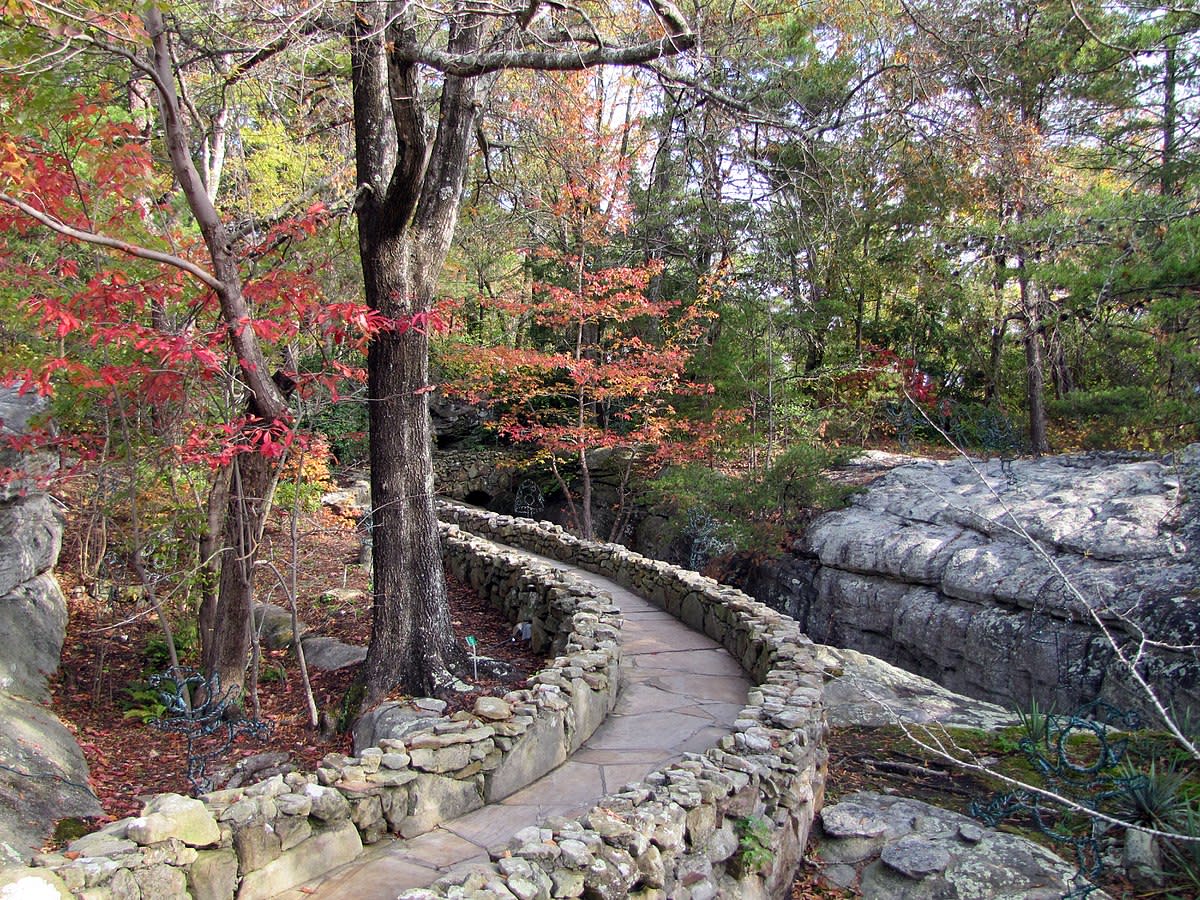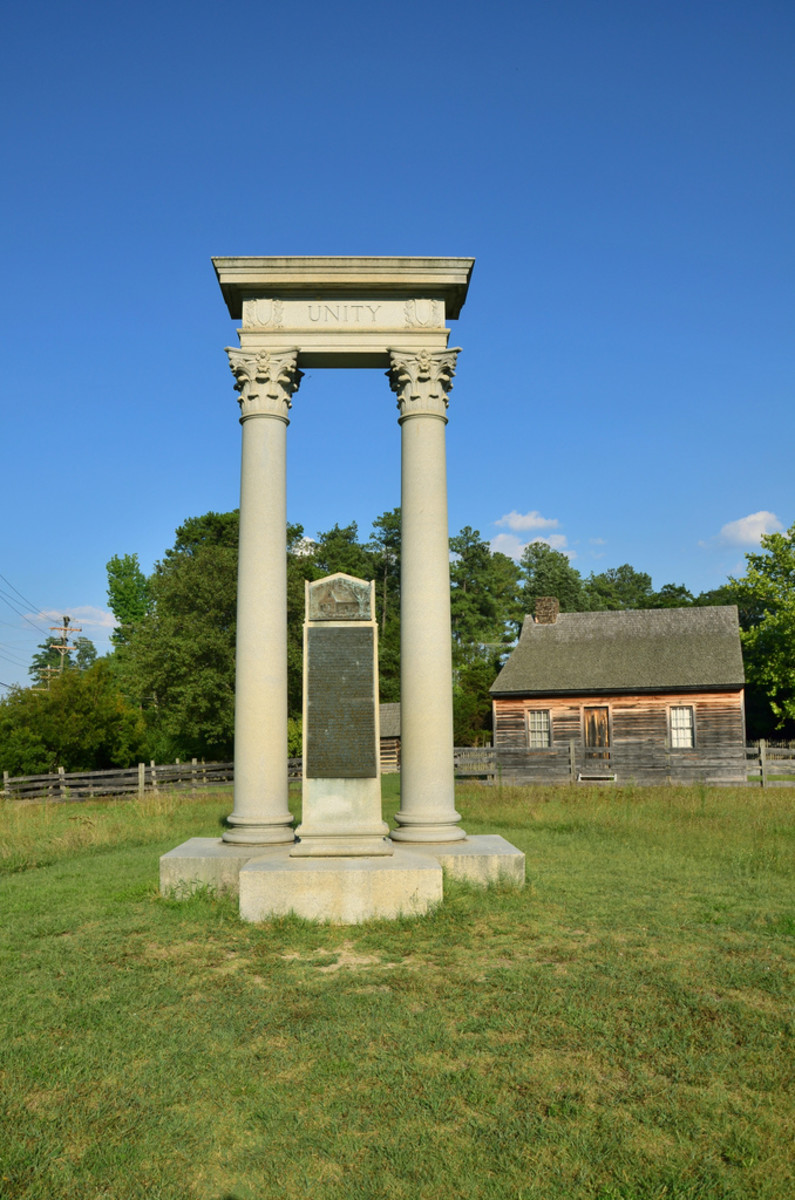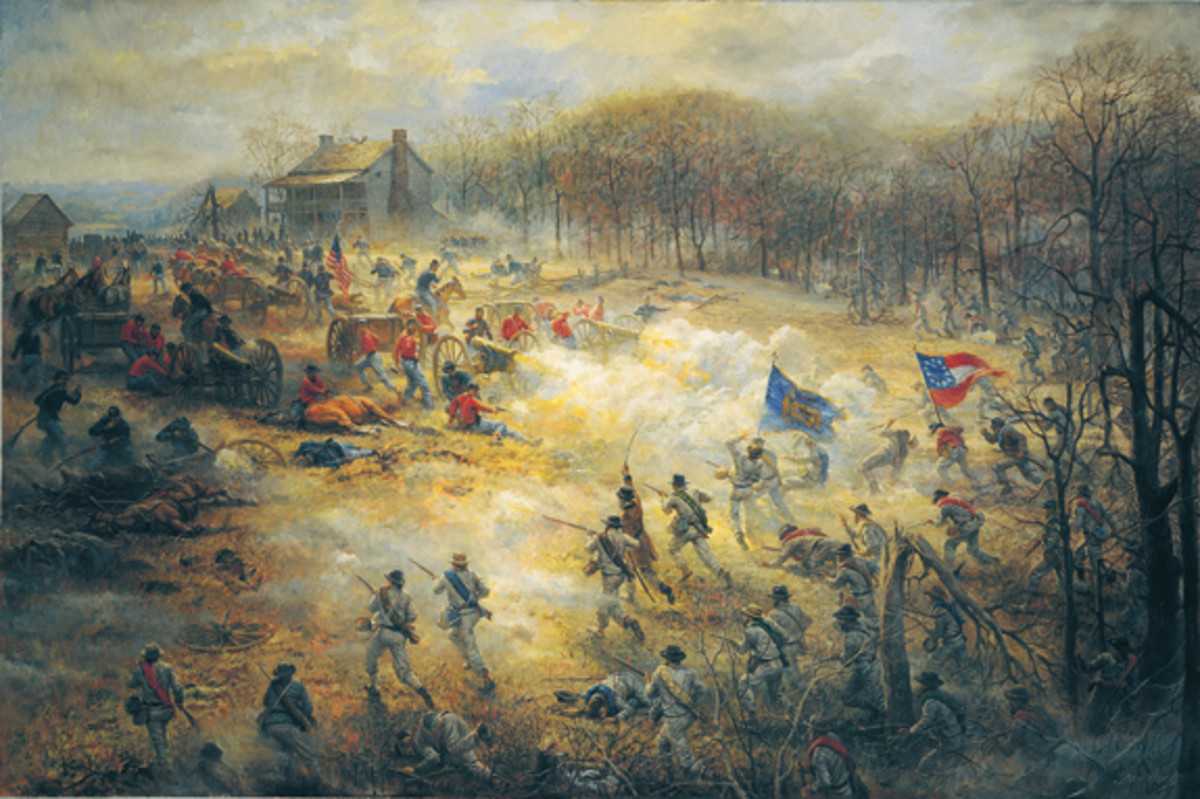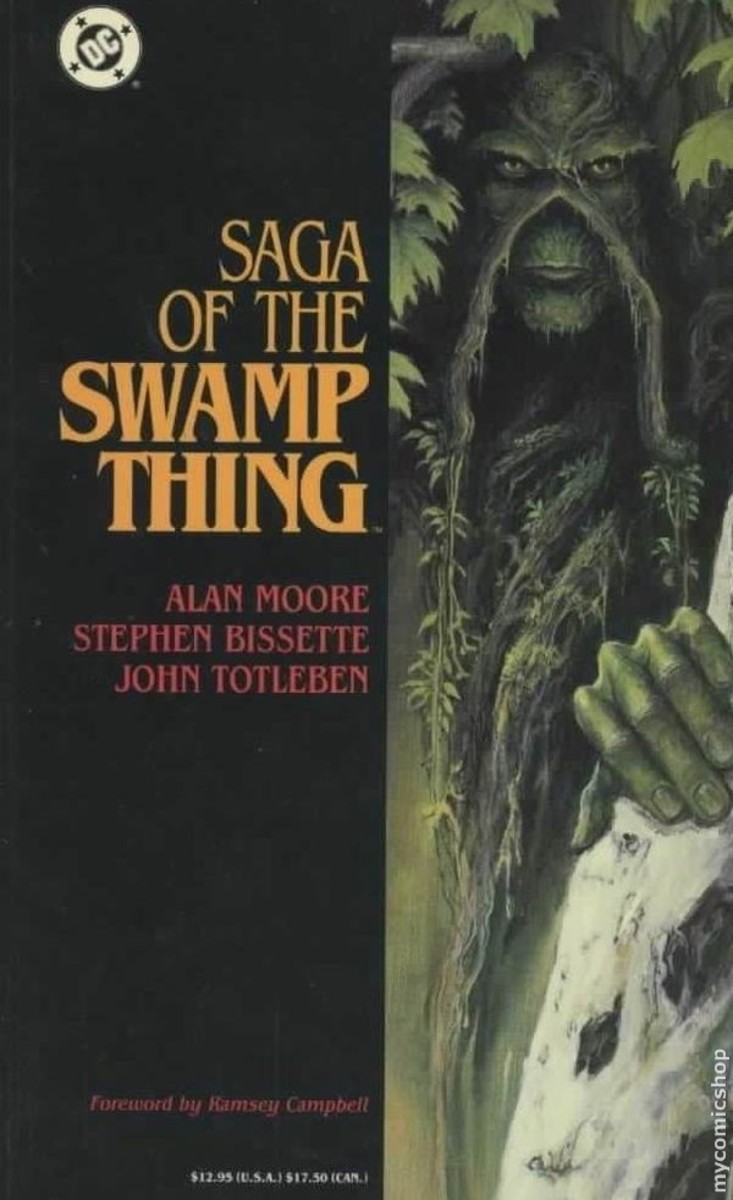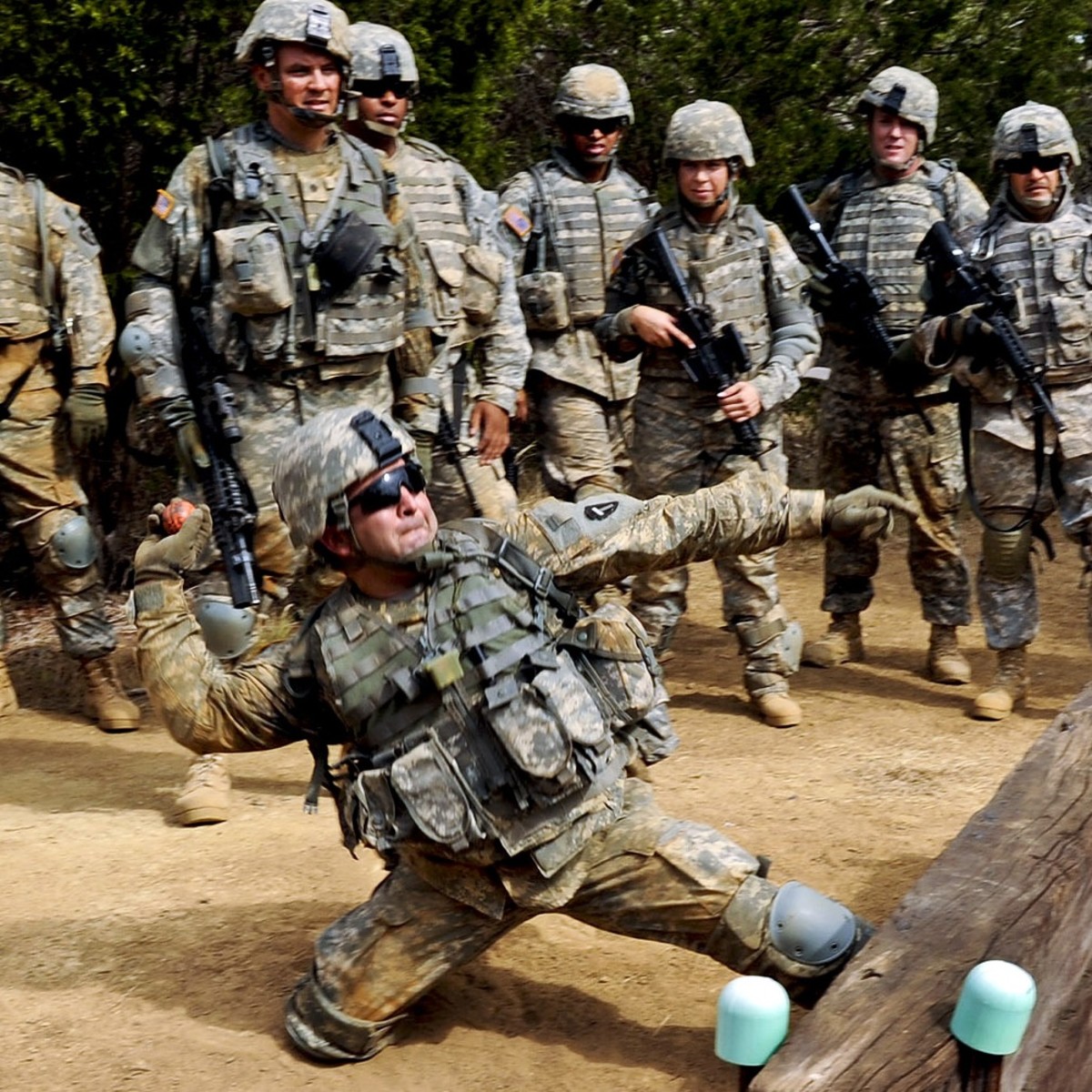The 42nd Alabama at The Battles of Lookout Mountain and Missionary Ridge
42nd Alabama at Chattanooga
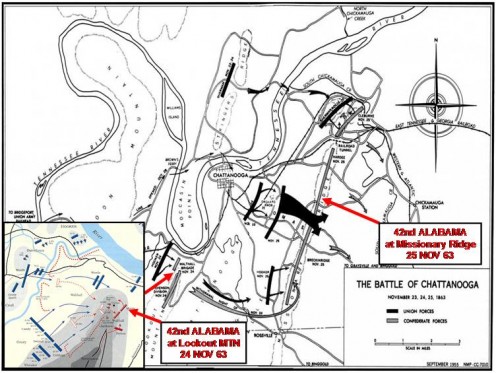
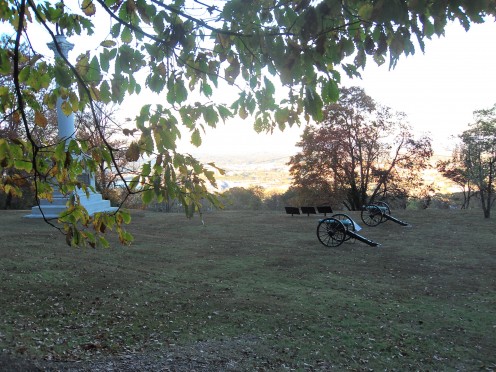
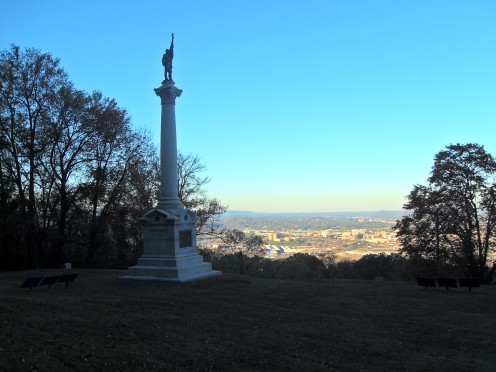
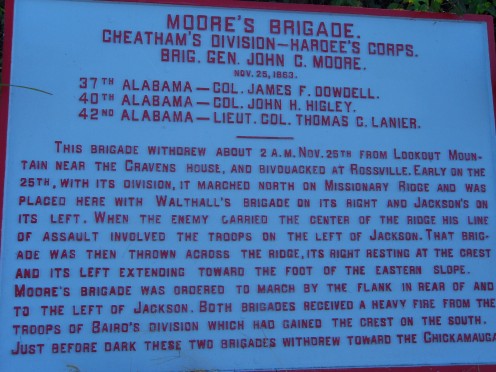
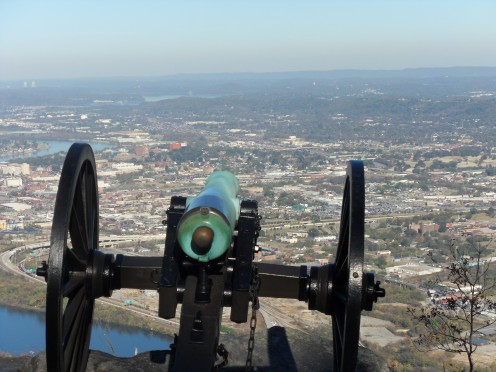
History of the 42nd Alabama
After the Confederate victory at Chickamauga, General Braxton Bragg and the Confederate Army of Tennessee pursued the Federal forces into Chattanooga and began the Siege of Chattanooga on September 23, 1863. Bragg positioned his forces on the surrounding heights of Missionary Ridge, Lookout Mountain, Orchard Knob, and Raccoon Mountain. Lookout Mountain towered 2500 feet above the Tennessee River Valley and covered the left flank of Bragg's siege line. Lookout Mountain was bordered on the west by Lookout Creek and on the east by Chattanooga Creek. On October 19, Grant moved his headquarters to Chattanooga and replaced Rosecrans with General George H. Thomas. Grant was determined to take the offense and break the siege of Chattanooga.
On October 1, 1863, the 42nd Alabama, along with Moore's brigade, was ordered to join the Army of Tennessee at Chattanooga. Upon release from parole, the regiment prepared for the move and was refitted with whatever the government could provide, which proved to be very poor equipment or nothing at all. General Moore protested, "My Brigade was supplied with a lot of arms and accouterments that had been condemned as unfit for service and piled up in an outhouse near the railroad depot. . . These arms were of many different calibers." [i] On October 29, armed with inferior weapons, the 42nd Alabama boarded railcars at Demopolis and moved to Selma, Alabama. After eight days of movement by rail, boat, and foot, the regiment arrived at Chickamauga Station on a cold and rainy November 5, 1863. [ii] Moore's brigade consisted of the 42nd, 40th, and 37th Alabama Regiments. Moore's, Edward C. Walthall's, and John K. Jackson's Brigades were assigned to the defenses on Lookout Mountain.
General Moore described his ill-equipped soldiers, "We were without tents . . . Many of the men were but scantily supplied with blankets as well as provisions . . . the men were frequently exposed to a cold north wind, the ground being sometimes covered with snow." [iii] First Lieutenant J. M. Huey of Company G, 42nd Alabama wrote a letter to The Democratic Watchtower, the local newspaper from Talladega County, requesting donated supplies for his poorly equipped company, "many of the men are entirely without blankets or any covering at night, many of them have no overcoats." [iv]
On November 12, General Jackson, the senior brigade commander, assumed temporary command of the three brigades. These troops occupied defenses near the Cravens house plateau and from the base of Lookout Mountain east to Chattanooga creek. On November 15, Jackson established his headquarters at the junction of the Sumnertown road and the Mountain-side road, above the Craven's House. In a November 15th letter, Corporal Robert J. Boyd Thigpin of Company C, 42nd Alabama described the conditions on Lookout Mountain, "You have heard of up hill business, but we have up hill business when we start up the side of this mountain. It is one eternal up . . . The prospects for rations are not flattering . . . I hope we will be fed for this is cold country and we will want all the flesh we can get on our bones to keep us warm." [v]
On November 23, General Stevenson assumed command of Bragg's left flank, which included the defenses on Lookout Mountain. Moore's brigade was stationed just below the Craven's House, on the right of Walthall's Brigade. Major General Carter Stevenson placed his division headquarters near the summit of Lookout Mountain along with General Edmund W. Pettus' Alabama Brigade and a portion of General John Brown's brigade in reserve.
On November 22, Private Taylor of the 40th Alabama wrote to his wife, "There is considerable cannonading this morning. This evening . . . there was a detail of men from our Regt and the 42nd Ala sent on picket. When they got near enough the Yanks threw a shell among them and wounded 11 from the effects of which one died that night and another had his leg cut off. They were all from the 42nd." [vi]
On November 24, Grant directed General Joe Hooker to assault Lookout Mountain with three divisions of approximately 10,000 soldiers. General Geary's division crossed Lookout Creek at Light's Mill at 8 AM and moved north along the base of Lookout Mountain toward the Confederate flank. A "dense fog enveloped" the base of Lookout Mountain and effectively concealed the approach of Hooker's units. Osterhaus and Cruft's Division crossed further north up Lookout Creek and moved east directly toward Walthall's pickets. Walthall's and Moore's pickets were stationed along Lookout Creek. Anticipating the advance, General Walthall placed a small patrol covering the crossings at Lookout Creek to provide advanced warning of any Union approach. Walthall's small party was captured and Moore lost 225 pickets captured by the advancing Union Forces. The surprise was so complete the pickets were unable to warn of the impending attack. Geary's division made contact with Walthall's brigade at 10 AM. The brigade was on the west side of Lookout Mountain, above Lookout Creek. Walthall's soldiers were spread extremely thin in poorly prepared positions. The fog had completely concealed Geary's approach, "Drifting clouds enveloped the mountain-top, and heavy mists and fogs obscured the slope . . . So impenetrable was this gloom around the enemy's locality that the movement became a complete surprise to him." [vii] Geary's division moved on the flank and rear of Walthall's brigade, forcing him to fall back. Moore advanced his brigade to reinforce Walthall's brigade near the Craven's House. Walthall's brigade fell back and attempted to form on Moore's left. Unfortunately, Walthall's brigade was in full retreat when the two units met. General Moore described the scene, "Just as our files turned out of the bench road near the Craven house we met the remnant of Walthall's brigade rushing to the rear in inextricable disorder. The officers seemed to be using every effort to arrest their flight, but the men rushed past them in spite of threats and even blow." [viii] General Jackson remarked, "Passing a great many stragglers - officers and men - along the road, I was met at some short distance from the Cravens house by an officer from General Walthall, who brought the information that his brigade had been driven back in considerable confusion." [ix] At about 1230 PM, Moore's brigade reached the rifle pits near the Craven's House, they held this position until approximately 3 PM, when their left flank was turned. Moore reported, "I have never before seen them fight with such daring and desperation . . . . We had now been engaged nearly three hours. We had but 30 rounds of ammunition . . . this supply was now nearly exhausted. . . . The enemy gradually pressed around my left with an increasing force; I reluctantly gave the order to fall back." [x]
General Jackson committed Pettus' brigade to reinforce Moore, "I rode back to the junction of the roads and there met General Pettus with three regiments of his brigade. He informed me that he had been ordered by General Stevenson to report to me. I directed him to proceed on the road and form line to reinforce General Moore and Walthall." [xi]
Moore's brigade, reinforced with Pettus' brigade and remnants of Walthall's brigade, formed a line approximately 300 yards southeast of the Craven's House. This line covered their line of retreat on the Summertown Road.
On the evening of November 24, Bragg arrived at Lookout Mountain to assess the situation. He realized holding Lookout Mountain against such odds was impossible. Bragg remarked, "I found we had lost all the advantages of the position. Orders were immediately issued to withdraw our forces across Chattanooga Creek" [xii] Bragg ordered General Stevenson to withdraw the remnants of his forces under cover of darkness to positions on Missionary Ridge. At 2 AM on 25 November, the 42nd Alabama retired from Lookout Mountain. A cold drizzle fell, leaving the soldiers miserable and cold.
During the early morning hours of November 25, Moore's brigade moved down Lookout Mountain and crossed Chattanooga Valley toward Missionary Ridge. Sergeant Major Joshua E. Preston, a twenty-one year old lawyer, described the 42nd Alabama's arrival at Rossville near Missionary Ridge, "At sunrise we reached the base of Missionary Ridge, and were halted to partake of an elaborate breakfast of corn bread and raw, fat bacon. The bread was three days old and the bacon of uncertain age." [xiii] After an hour, the brigade moved to a position along Missionary Ridge and was placed in the center of General Frank Cheatham's division with Walthall's brigade on Moore's right and Jackson's brigade on Moore's left.
At 3:30 PM, Union Forces under General Thomas advanced against the center of the Confederate Forces on Missionary Ridge. One of Moore's soldiers stated, "they came forward in fine style-great black masses, rolling forward like ocean waves." [xiv] Bragg's center broke under the weight of Thomas' assault. Bragg described the situation, "A panic which I had never before witnessed seemed to have seized upon officers and men, and each seemed to be struggling for his personal safety, regardless of his duty or his character." [xv] The Confederate center then crumbled and "disappeared like frost before the morning sun." [xvi]
General Moore commented, "we did not feel as frisky as a lot of schoolboy's the following day, not even when the Federals decided to pay us another visit." [xvii] Despite the desperation presented, Moore, anticipated the collapse on the crest of the ridge, and adjusted his remaining elements perpendicular to Missionary Ridge to cover Cheatham's left flank. Thomas' troops moved across Missionary Ridge toward Moore's brigade. A soldier of Moore's brigade recalled, "The whole brigade-37th, 40th, and 42nd Alabama regiments-made a gallant charge driving the enemy back until a part of the works that had been abandoned were recaptured, but were finally compelled to fall back to the point from which they started, where they immediately reformed and charged again over the same ground, already strewn with our dead and wounded. We succeeded in checking the enemy and holding them in check until after dark when the army retired across Chickamauga Creek. Our brigade suffered heavily in these two charges." [xviii] Elements of the 42nd Alabama were captured on the crest of Missionary Ridge, possibly during these counter-attacks. The commander of the 25th Illinois remarked, "The battle-flag of the Forty-Second Alabama Regiment, and a number of prisoners captured." [xix] Moore reported, "The enemy made great efforts to drive us from the position, but failed. We determined to hold it at all hazards, believing that the safety of the right wing . . . depended on our holding this position . . . We held until nearly dark . . . informed that an order had been passed down the line from Lieutenant-General Hardee to fall back." [xx] Afterwards General Cheatham stated, "Boys, Moore's brigade saved the Army of Tennessee tonight." [xxi]
The action on Missionary Ridge resulted in a complete route of the Army of Tennessee. Beatty's brigade captured 176 soldiers, many of these from the 42nd Alabama. One of these prisoners was twenty-three year old Major Washington C. Fergus, the Regimental Major of the 42nd Alabama. [xxii] Washington would spend the remainder of the war at Johnson Island Prison. Under the cover of darkness, Bragg collected the remnants of his shattered Army and retreated south toward the railhead at Chickamauga. This ended the long siege at Chattanooga. Casualties for the regiment during the fighting at Chattanooga were the lightest in the brigade but, at 14.8% total casualties the 42nd Alabama suffered the average level of casualties as the entire Army of Tennessee. Late on the night of November 25, the 42nd Alabama reached Chickamauga Station. Overall Moore was pleased with the performance of his ill-equipped brigade at Chattanooga. He remarked, "My own command acted much better than might have been expected under the circumstances, as they fought during the engagements of the two days with arms that had been condemned as unfit for service, and which were received while at Demopolis, Ala., to be used only for drill and guard duty." [xxiii]
The Army of Tennessee moved to Dalton, Georgia for winter camp and reconstitution. Bragg resigned as the commander of the Army of Tennessee following his defeat at Missionary Ridge. The Army of Tennessee was shattered and demoralized. One soldier of Moore's brigade described desertions at a rate from six to thirty every day. [xxiv] On December 14, the 42nd Alabama had a total effective force of 311. [xxv] In a letter to his wife, Private R. B. Ledbetter of Moore's brigade described the demoralization of the soldiers within the Army of Tennessee, "Old Jeff don't feed his servants well. I am of the opinion that a great many of them will run away from him . . . I think the men of this army intend to run out of every battle not because they are afraid but because they have lost confidence in the cause . . . I think this Confederacy is about played out . . . I consider this army perfectly demoralized" [xxvi]
[i] John C. Moore, "The Battle of Lookout Mountain", Confederate Veteran, (1898) 6: 426.
[ii] Willet, Elbert Decatur, History of Company B, 40th Alabama Regiment Confederate States Army. 44-45.
[iii] John C. Moore, "The Battle of Lookout Mountain", Confederate Veteran, (1898) 6: 426.
[iv] Huey, The Democratic Watchtower, Vol. 24, Number 41, 11 November 1863 Military Notice.
[v] Personal Letter of Robert J. Boyd Thigpen dated 15 November 1863.
[vi] Robert A. Taylor, This Cruel War, (Macon, GA: Mercer University Press, 2000) 90.
[vii] Gilbert C. Kniffin, "The Battle above the Clouds", Military Order of the Loyal Legion of the United States, (Broadfoot Publishing, 1889), 140.
[viii] John C. Moore, "The Battle of Lookout Mountain", Confederate Veteran, (1898) 6: 428.
[ix]OR, 31.2 (Washington, D.C. U.S. Government Printing Office, 1880-1901), 689.
[x] Ibid., 705.
[xi] Ibid, 689.
[xii] Ibid., 664.
[xiii] Preston, "The Battle of Lookout Mountain", Confederate Veteran, (1898) 6: 110.
[xiv] Samuel H. Sprott, Cush; A Civil War Memoir, (University of West Alabama: Livingston Press, 1999), 71.
[xv]OR, 31.2, (Washington, D.C. U.S. Government Printing Office, 1880-1901), 665.
[xvi] Samuel H. Sprott, Cush; A Civil War Memoir, (University of West Alabama: Livingston Press, 1999) 71.
[xvii] John C. Moore, "The Battle of Lookout Mountain", Confederate Veteran, (1898) 6: 429.
[xviii] Samuel H. Sprott, Cush; A Civil War Memoir, (University of West Alabama: Livingston Press, 1999), 72.
[xix]OR, 31.2, (Washington, D.C: U.S. Government Printing Office, 1880-1901), 266.
[xx] Ibid., 706.
[xxi] Samuel H. Sprott, Cush; A Civil War Memoir, (University of West Alabama: Livingston Press, 1999), 74.
[xxii]OR, 31.2, (Washington, D.C. U.S. Government Printing Office, 1880-1901), 302.
[xxiii] Ibid., 706.
[xxiv] Greene Family Papers, personal letter E.W. Greene Co D 37th Alabama. Dated 1863. Microfilm Drawer 199, Box 69, Georgia Archives.
[xxv]OR, 31.3, (Washington, D.C. U.S. Government Printing Office, 1880-1901), 822.
[xxvi] Personal Letters of R. B. Ledbetter, Company D, 40th Alabama Regiment. Dated 25 December 1863. Microfilm Drawer 199, Box 69, Georgia Archives.


